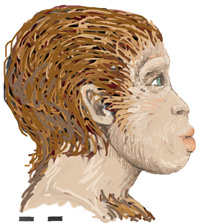The Genus Australopithecus
About 4.4 millions
years ago, a different type of primate emerged.
The first bipedal primates are classified by Paleontologists
as
hominids, and these first hominids had not yet developed the
large
brain, teeth structure, and skeletal features identified as Homo.
Instead, they predate, and sometimes overlap the first Homo species
and are known as the Australopithecines. The two types of
australopithecines are gracile and robust.
____________________________________________________
AUSTRALOPITHECUS ANAMENSIS
4.0-3.9 million years ago
This species has recently been found in the Lake Turkana region in Kenya
and dates back to 4 million years ago. Though not recognized as such for
30 years, the first Australopithecus anamensis discovery occurred in the Kanapoi
region of East Lake Turkana in 1965 by a Harvard University expedition. The
initial find consisted of a partial left humerus. Aside from a solitary molar
discovery in 1982, virtually no further A. anamensis specimens were found
until the early 1990's, at which time, Meave Leakey and other affiliates of
the National Museums of Kenya organized a research team for the Kanapoi region.
Around 3.9 million years ago, A. anamensis evolved into Australopithecus
afarensis. It provides the first fossil evidence as the first and
earliest biped. The Australopithecus anamensis tibia indicates bipedalism.
It is the first species to walk upright!
Some characteristics:
The cranial capacity of the Australopithecus anamensis is unknown.
Male height is around 5 feet, while the females are around 4’3”. The male
weight is around 110 lbs, while the female weight is around 70 lbs.
Their teeth and jaws are hominid but have some similarities to the chimpanzee.
They retained ape-like crania and dentition, while also exhibiting rather
advanced postcrania, more or less typically hominid-like in form. The joints
on their leg bones indicate bipedal gait.
http://www.archaeologyinfo.com/australopithecusanamensis.htm
http://www.archaeologyinfo.com/ images/ramidus.JPG
_____________________________________________________
AUSTRALOPITHECUS AFARENSIS
Australopithecus afarensis
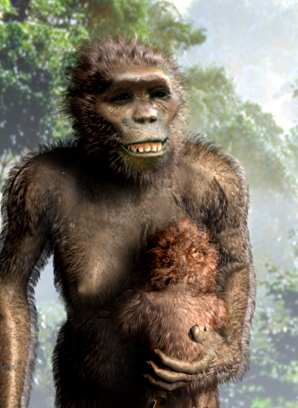
Australopithecus afarensis was named as a species in 1978 by D. Jonhanson
and T. White. It is one of the better know Australopithecines because a
large number of fossils have been found and attributed to this species.
Fragments of more than 300 individuals of Australopithecus afarensis
have been discovered so far in Tanzania, Kenya and Ethiopia. Australopithecus
afarensis lived from approximately 4.1 to 2.7 million years ago in northeastern
Africa.
The most famous specimen is “Lucy,”
a nearly complete skeleton found in 1974 at Hadar, Ethiopia. The illustration
on the right shows "Lucy" in comparison with a modern human female. She was
only about 3 feet, 8 inches tall. Males were somewhat taller and twice as
robust (sexual dimorphism).
A. afarensis is still
very apelike but does have some characteristics of Homo sapiens
. For example,“Lucy’s” overall body size, brain size and skull shape
resemble a chimpanzee. However, A. afarensis walked upright like a human,
not like a chimp. Evidence for bipedalism comes from skeletal fossils
showing pelvis articulation and femur (thigh bone) similar to humans. Irrefutable
evidence comes from the Laetoli footprints. There is no tool making associated
with A. afarensis.
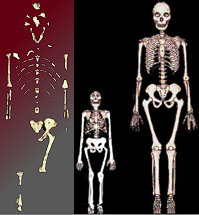 Lucy's skeleton and Lucy vs. modern human
female
Lucy's skeleton and Lucy vs. modern human
female
The distinctive characteristics of
A. afarensis were: 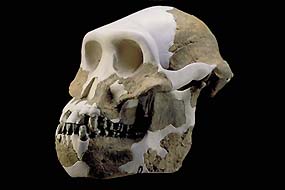
- a low forehead
- bony ridge over the eyes
- a flat nose and no chin
- more humanlike teeth,
- and the pelvis and leg bones
resembled those of modern man.
- Females were smaller than males.
Many scientists believe Australopithecus afarensis was still
active in trees because the fingers and toe bones of the species were
curved and longer than the ones of the modern human. Also, its upper torso
is stronger than ours and its arm and leg lengths are similar which also
indicates the species was adapted to tree climbing.
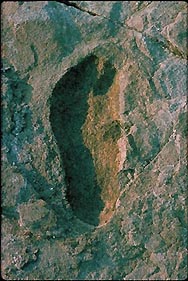 Laetoli Footprints
Laetoli Footprints
The footprints of A.
afarensis were discovered by Mary Leakey in 1974 at Laetoli, Tanzania.
The find dates to 3.6 million years ago. The prints were made after
a volcanic erruption and were quickly covered by a subsequent eruption
which preserved the footprints. At least two individuals walkind
side by side are represented. Not only do the prints show that A. afarensis
walked upright but also lacked the divergent toe associated with chimps.
Links:
Australopithecus afarensis
Species Timeline
Human Ancestor Hall: Australopithecus afarensis
Origins of Humankind- Research center: A. afarensis
___________________________________________________
AUSTRALOPITHECUS BAHRELGHAZALI
3.5 - 3.0 million
years ago.
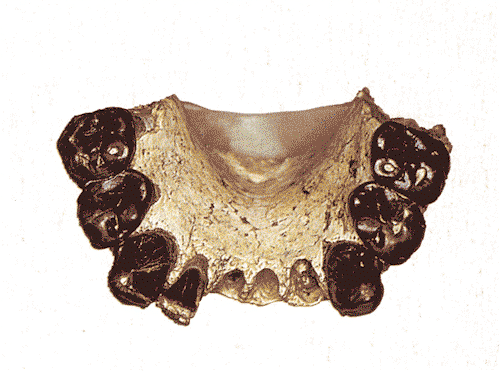 A. bahrelghazali
was discovered by Michel Brunet in 1993, in the ancient
riverbed of Bahr el Ghazal in Chad, located 2,500 kilometers west of the
East African Rift Valley. This is currently the first and only australopithecine
specimen to be found in North-Central Africa, and is also the furthest west
of any specimen found to date.
A. bahrelghazali
was discovered by Michel Brunet in 1993, in the ancient
riverbed of Bahr el Ghazal in Chad, located 2,500 kilometers west of the
East African Rift Valley. This is currently the first and only australopithecine
specimen to be found in North-Central Africa, and is also the furthest west
of any specimen found to date.
There are arguments against the case for A. bahrelghazali being its
own species because of its resemblances to Australopithecus afarensis
. However, the mandibular symphysis is more modern in appearance
than that of A afarensis. Although the species designation of
Australopithecus bahrelghazali is a new one, it is currently gaining
more and more support among scientists.
http://www.msu.edu/~heslipst/contents/ANP440/bahrelghazali.htm
IMAGE:
http://www.scienceinafrica.co.za/ pics/origin5a.gif
___________________________________________________
AUSTRALOPITHECUS
AFRICANUS
3.0-2.5 million years
ago
Raymond Dart discovered the first australopithecine in November, 1924. The
fossil was found at a lime quarry at Taung, southwest of Johannesburg, and
was of an immature apelike individual. The fossil existed of the face, part
of the cranium, the complete lower jaw and a brain endocast, formed when
sand inside the skull hardened to rock, recording the shape of the brain.
Dart stated that the Taung
individual was an earlier form of human, and named it Australopithecus
africanus ("southern ape from
Africa"). Australopithecus africanus appeared to be apelike in having a
protruding face and small brain, but had distinctly unapelike dentition,
including small canines and large, flat molars. A bipedal posture was again
indicated by the central position of the foramen magnum, and by the anatomy
of the spine, pelvis, and femur.
Links:
http://www.geocities.com/palaeoanthropology/Aafricanus.html
_____________________________________________________
AUSTRALOPITHECUS GARHI
Australopithecus garhi was believed
to have existed between 2 and 3
million years ago in the middle Awash region
of Ethiopia. The first
parts of garhi to be discovered were the skull, teeth, and limb bones
and were found by Berhane Asfaw and Tim White. This was a significant
and surprising find because garhi had a small brain, yet used and made
tools to crack open the limb bones of animals in order to get to the
nutrient-rich marrow at the center of the bone. Fittingly, the word
garhi means surprise in the local Afar language of Ethiopia. Before the
discovery of A. garhi, the first tool users were thought to be of the
Homo genus. A. Garhi, therefore, is thought to have been a link
between
Australopithecus and Homo because of the small brain/tool using
combination. A. garhi appeared to exist during the hypothetical
tunnel
of time, from which species went in at about 3 million years not using
tools, not very well adapted to their environment, and with small brains
and came out at about 2 million years ago using tools, well adapted to
their environment, and with large brains.
www.modernhumanorigins.com/garhi.html
http://www.ashtonfarm.demon.co.uk/early_hominid_evolution/a_garhi.htm
http:// biology.about.com/library/weekly/aa042999htm



 Laetoli Footprints
Laetoli Footprints A. bahrelghazali
was discovered by Michel Brunet in 1993, in the ancient
riverbed of Bahr el Ghazal in Chad, located 2,500 kilometers west of the
East African Rift Valley. This is currently the first and only australopithecine
specimen to be found in North-Central Africa, and is also the furthest west
of any specimen found to date.
A. bahrelghazali
was discovered by Michel Brunet in 1993, in the ancient
riverbed of Bahr el Ghazal in Chad, located 2,500 kilometers west of the
East African Rift Valley. This is currently the first and only australopithecine
specimen to be found in North-Central Africa, and is also the furthest west
of any specimen found to date. 